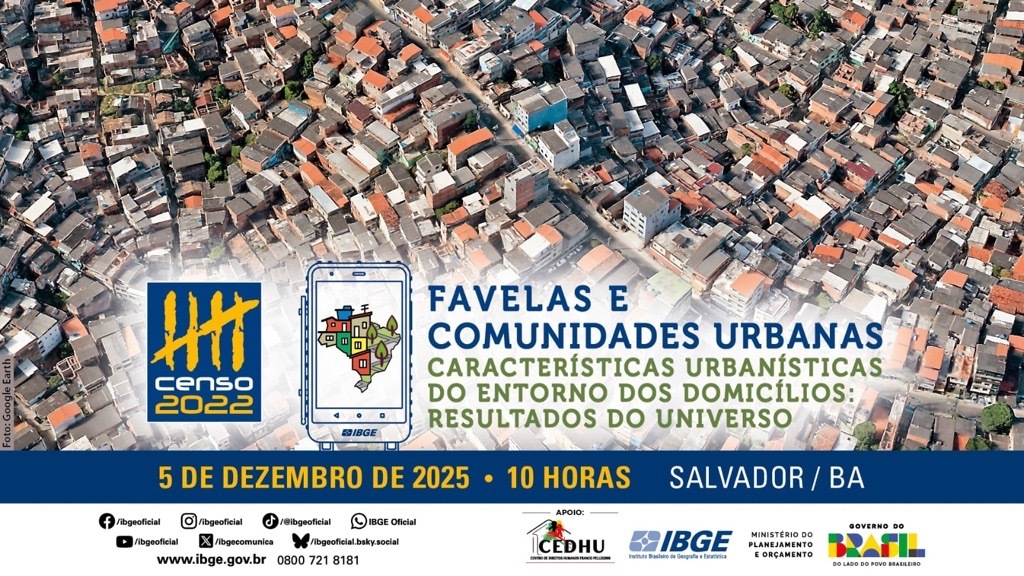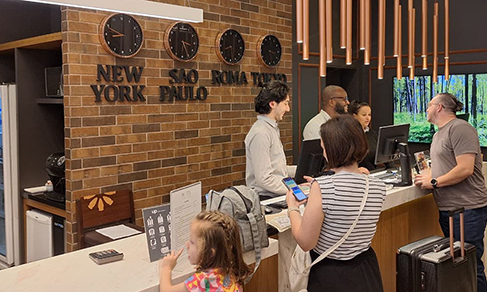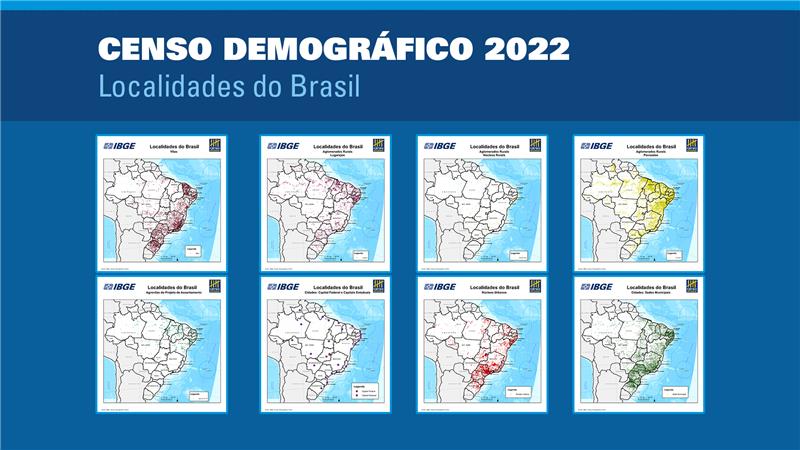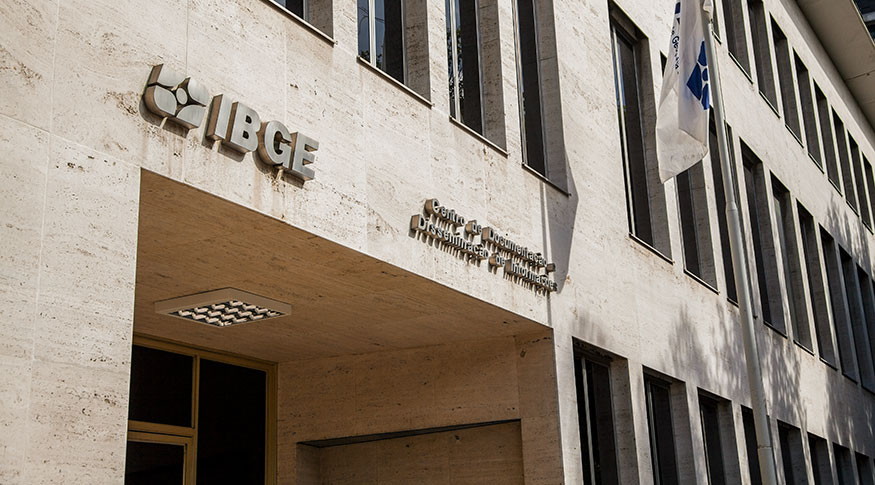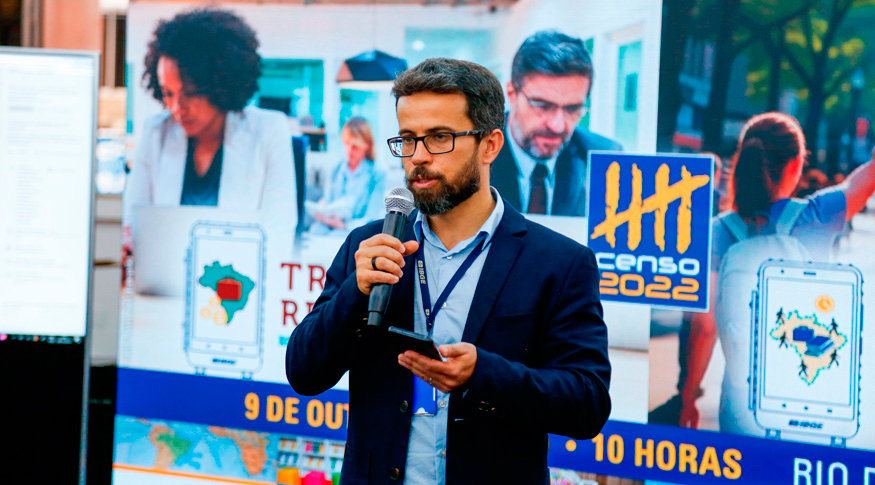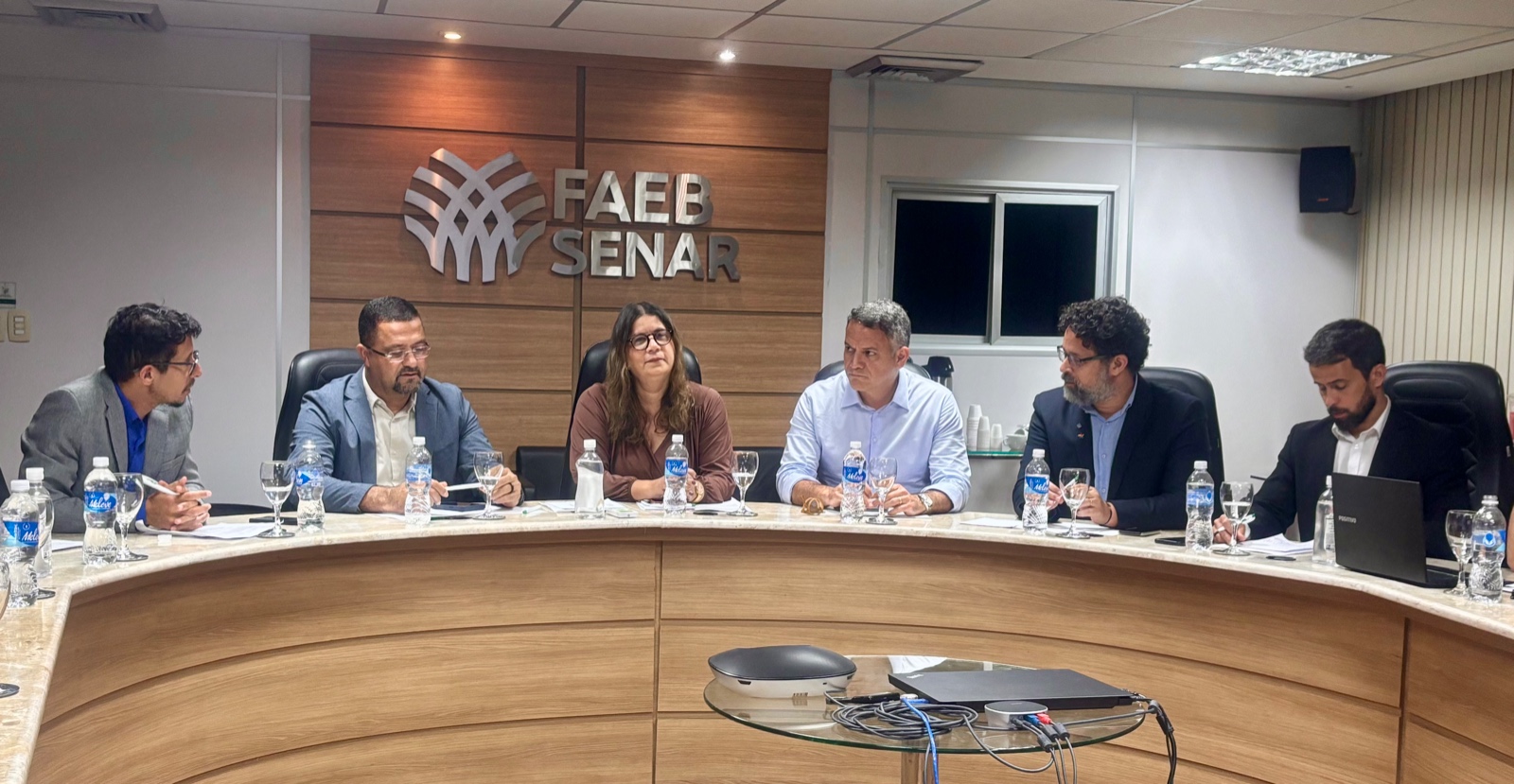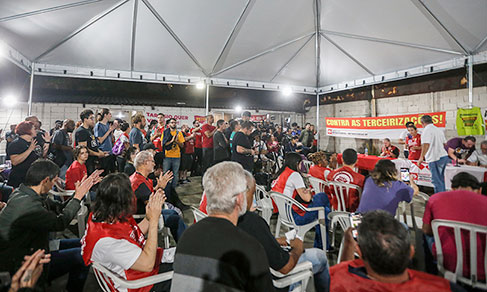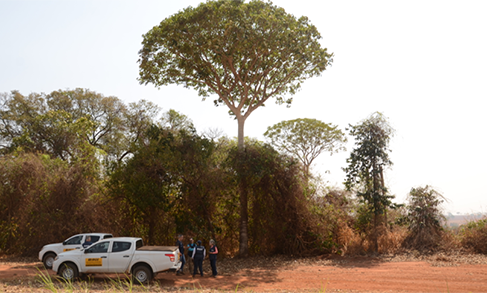Continuous PNAD
Internet was accessed in 72.5 million Brazilian households in 2023
August 16, 2024 10h00 AM | Last Updated: August 20, 2024 04h57 PM
Highlights
- In 2023, 72.5 million households used the Internet (92.5%), an increase of 1.0 p.p. over 2022. In urban areas, the percentage changed from 93.5% to 94.1% and, in rural areas, from 78.1% to 81.0%.
- The growth has accelerated in rural areas, reducing the difference in relation to urban areas: in 2016, the difference was higher than 40 p.p. (35.0% versus 76.6%) and dropped to 13.1 p.p. in 2023.
- Between 2022 and 2023, the percentage of households with Internet that used mobile broadband rose once again, changing from 81.2% to 83.3%, though it remained below the landline broadband, which changed from 86.4% to 86.9%.
- Proportion of households receiving analog or digital open TV signal through a conventional antenna fell from 91.6% in 2022 to 88.0% in 2023, a drop of half million households.
- The proportion of households without open or pay TV signal rose from 3.9% in 2022 to 5.2% in 2023.
- 42.1% of the households had a paid service of video streaming. Among the households with streaming service, 6.1% did not access open TV or pay TV service, having registered 4.7% in 2022.
- The percentage of households with microcomputer declined: from 40.2% in 2022 to 39.0% in 2023. That percentage had been 45.9% in 2016.
- The proportion of households in which the mobile network service works for the Internet or telephony was 91.9% in 2023, showing a slight negative change of 0.1 p.p. in relation to the previous year for the first time ever.
- That proportion was 95.3% in urban areas and 67.4% in rural areas, with a reudction of 2.0 p.p. in rural areas and an increase of 0.1 p.p. in urban areas.

The internet was used in 92.5% of the Brazilian households (72.5 million) in 2023, a rise of 1.0 p.p. over 2022. The growth of that proportion has been decelerating, inasmuch as it approaches universalization. In urna areas, the percentage changed from 93.5% to 94.1% and, in rural areas, from 78.1% to 81.0%. The expansion has been faster in rural areas, with a reduction of the difference in relation to urban areas, changing from 40 p.p. of difference in 2016 to 13.1 p.p. in 2023.
The data are from the Module of Information and Communication Technology (ICT) of the Continuous PNAD, released today (16) by the IBGE. Read the new on use of the Internet by persons aged 10 years and over as well.

Until 2019, both types of broadband connection (landline and mobile) gradually grew in the households, whereas mobile broadband reduced in 2021 and rsumed its growth in 2022 and 2023. Landline broadband remeind increasing between 2016 and 2023, reaching a higher rate than that of the mobile broadband from 2021 onwards.
In the Brazilian households with Internet use, the percentage of those who used mobile broadband changed from 81.2% to 83.3% between 2022 and 2023. While the percentage of households that used fixed broadband increased from 86.4% to 86.9% in the same period.
The lowest percentage of households with mobile broadband was in the Northeast (68.2%), whereas the other regions recorded rates higher than 80%, even higher than 90% in the Southeast Region.
5.9 million Brazilian households did not have Internet
In 2023, 5.9 million Brazilian households did not use the Internet. The three main reasons were: no resident knew how to use the Internet (33.2%), service of Internet access was expensive (30.0%) and no need to access the Internet (23.4%).
Other reasons mentioned were: service of Internet access was not available (4.7%), equipment to access the Internet was expensive (3.7%), lack of time (1.4%) and concern with security (0.6%).
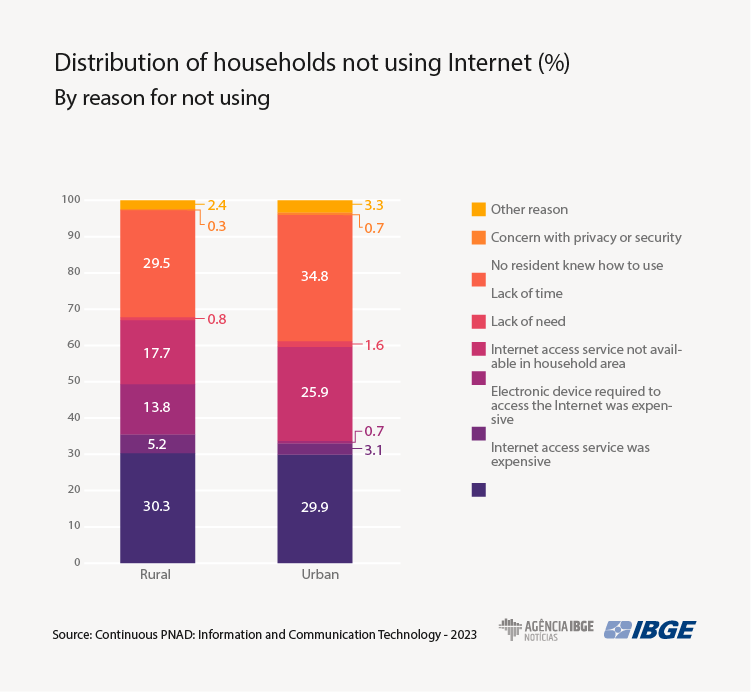
Smart devices are used in 16.0% of the households with Internet
Among 72.5 million households with Internet in 2023, 16.0% (or 11.6 million) had some sort of smart devices that could be accessed through the Internet - cameras, sound boxes, lights, air conditioners, refrigrators, etc. -, an increase of 1.7 million households (or 1.7 p.p..) compared with 2022.
Proportion of households with opne TV signal falls from 91.6% to 88.0%
Of the 78.3 million permanent private households in Brazil in 2023, TV was available in 73.9 million, 94.3% of the total number of households, a proportion that stayed at 95.1% in urban areas and at 88.5% in rural ones. The Southeast and South regions registered the highest proportions of households with TV (96.5% and 96.0%, respectively) and the North Region, the lowest one (88.8%).
65.0 million households receiving analog or digital signal of open TV through conventional antennas were estimated, the equivalent to 88.0% of the household with TV in Brazil. That information represents a drop of half million households with receivers in relation to 2022, which had 65.5 million households and 91.6%, respectively.
The percentage in the urban area (88.9%) was higher than in the rural area (80.9%). The Southeast Region recorded the highest percentage, with 88.9% of the households, and the Central-West Region registered the lowest percentage (86.8%).
"Despite the reduction in the reception of open TV signal, we did not perceive an increase in the use of complementary or concurrent ervices, like streaming and pay TV, whose rates reduced as well," highlights Leonardo Quesada, an anlyst of the survey.
772 thousand households used analog satellite dishes exclusively to access TV channels, nearly 1.0% of the total
A higher number of households receiving signal through a large satellite dish (9.1 million) were available in Brazil than those that had mini satellite dishes with open signal (7.5 million), which represented 12.3% and 10.2% of the households with TV, respectively. Yet, the difference between the two types of antenna dropped from 5.5 million in 2022 to 1.6 million in 2023.
Nearly 772 thousand households (911 thousand in 2022), or 1.0% of the households with TV, accessed TV signal only through large satellite dishes.
"This is the group of interest that needs to change the structure of TV reception to mini satellite dishes, since the access to open TV will be jeopardized due to the end of the transmission through large satellite dishes. Despite the drop of 139 thousand households or 15.3%, most of them came from urban households (117 thousand or 20.9%) compared with rural households (22 thousand or 6.3%), the segment that mostly depends on large satellite dishes. It should be remined that the change is costly, being free only for those included in the Single Registry for Social Programs of the Federal Government," explains Quesada.
Use of pay TV decreases both in urban areas and rural ones
In 2023, 18.6 million or 25.2% of the households with TV in Brazil accessed a pay TV service, a proportion that was of 26.2% in the urban area and of 17.4% in the rural area. Between 2022 and 2023, the percentage of households with pay TV reduced 2.5 p.p. in Brazil, and dropped 2.6 p.p. in urban areas and 2.4 p.p. in rural ones. "Since 2016, the percentages of the rural households were growing, hitting the highest level in 2022 (19.8%), though it dropped for the first time in 2023 to 17.4%," highlights the survey´s analyst.
3.8 million households have no type of TV service
The survey also shows the number of households with TV not receiving any analog or digital open TV signal, not receiving any signal through large satellite dishes or mini satellite dishes with open signal and not accessing any pay TV service changed from 2.7 million (3.9%) of households in 2022 to 3.8 million in 2023 (5.2%).
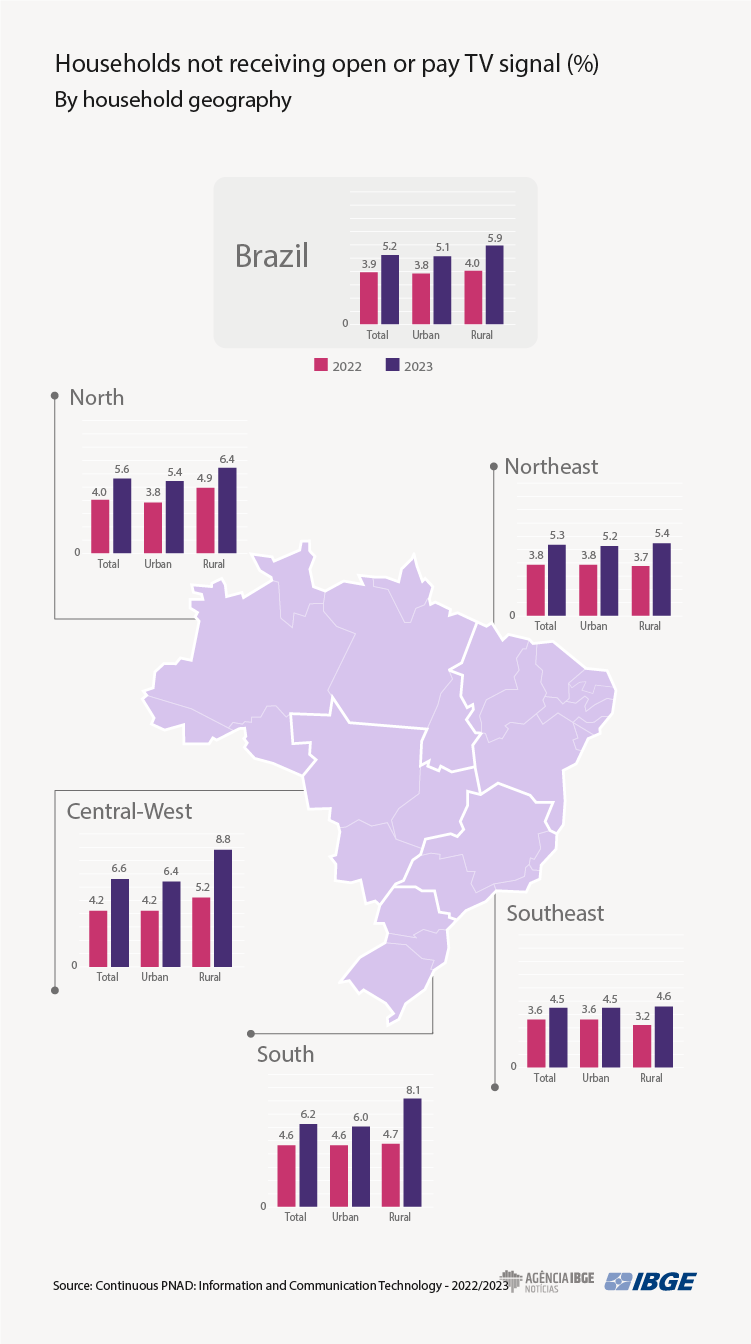
Of the households with paid video streaming service, 6.1% did not access either open or pay TV.
Among the households with TV, 31.1 million accessed a paid video streaming service, a number similar to 2022. However, in percentage terms, it dropped from 43.4% to 42.1%.
Among the households that accesses a paid video streaming service, 93.9% aldo accessed TV channels: 89.7% through open TV signal and 39.5% through pay TV service. Only 6.1% of those accessing paid video streaming did not access open TV or pay TV service, being 4.7% the percentage in 2022.
Proportion of households with microcomupters and tablets drops
Between 2022 and 2023, the proportion of households with microcomputers retreated from 40.2% to 39.0%. In 2016, the percentage had been 45.9%. The proportion of households with tablets retreated once again ,from 10.7% to 10.4%. Since 2021, this indicator showed close percentages, with slight variations upward and downward, indicating some stability around 10%. In urban areas, this indicator changed from 11.8% to 11.4% and, in rural areas, from 3.1% to 2.8%.
Number of households with landline phones remains decreasing
In 2023, 2.8% of the Brazilian permanent private households (2.2 million) had no telephone at all, the same percentage as in 2022. The lack of telephones remained higher in households in the Northeast (5.2%) and North (3.8%) regions, whereas it did not surpass 2.0% in the other regions.
The proportion of households with landline telephones in Brazil was 9.5%, a percentage that declines since 2016. On the other hand, the parcel of households with mobile phones has been increasing since 2016 (93.1%), though it remained virtually stable in 2022 (96.6%) and 2023 (96.7%). Household in the rural area had a lower pecentage compared with those of urban areas, both in terms of mobile phones (91.2% against 97.5) and landline phones (2.8% against 10.5%).
Mobile phone network service works for Internet or telephony in 91.9% of the households
Since 2016, year after year, the number of households that informed that a mobile phone network service worked there increased, either for the Internet or telephony. However, for the first time in the time series, the percentage of households in this condition registered a slight negative change of 0.1 p.p., indicating a possible stability in this indicator. The percentage of Brazilian households with a mobile phone network service working either for the Internet or telephony was 91.9% in the entire country, 95.3% in urban areas and 67.4% in rural areas.
Rural areas reduced both the number of households (less 202 thousand households) and the rate (drop of 2.0 p.p.). Conversely, urban areas recorded an increase of 2.9 million households and a positive variation of 0.1 p.p. in the rate. Such movement improved the difference between the rates in urban households compared with rural ones: in 2016, that difference was of 26.0 p.p. and, in 2023, it changed to 27.9 p.p., becoming the highest one in the time series.
More about the survey
Since 2016, the module of Information and Communication Technology (ICT) of the Continuous National Household Sample Survey (Continuous PNAD) analyzes the access to the Internet and TV and ownership of mobile phones for personal use, geographically detailed for Brazil, Major Regions and Federation Units. For more information, please access the complete publication and the support material.


